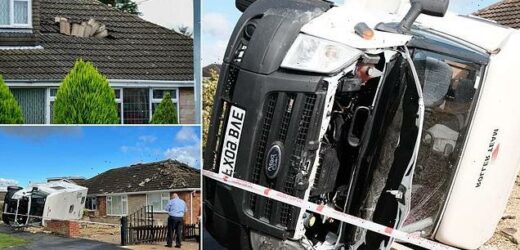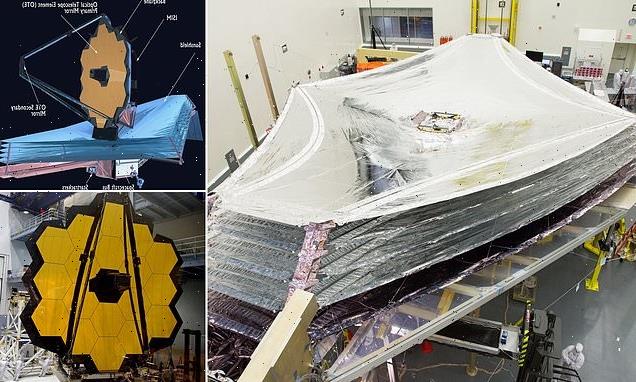Villagers whose homes were damaged in freak TORNADO that dumped three-tonne campervan onto house are still waiting for repairs to be carried out due to battle with insurers
- A campervan was lifted 20ft in the air and hurled across a Lincolnshire street
- Residents are still struggling with home repairs three months after the incident
- One claimed insurers would not pay out because wind speed was ’48mph’
- Resident said: ’48mph wind is not enough to lift a campervan and do all this’
- Another local claims dealing with insurers has been ‘nothing but hassle’
Villagers are still living in damaged homes and waiting for repair work to be finished more than three months after a freak tornado.
A three-tonne campervan had been hurled 20ft in the air before falling into a neighbouring property in Humberston, Lincolnshire, battering properties in its wake at around 9.30am on September 27.
The vehicle, along with others on Buttermere Crescent, was written off after it wreaked havoc across two other roads – Coniston Crescent and Derwent Drive.
But three months later, residents are still struggling with home repairs, and finding tradesmen to help with the job is proving a challenge, Grimsby Live reports.
One resident, who did not wish to be named, claimed insurers will not pay out because the wind speed was ‘just 48mphs, according to their survey’, meaning it is not classed as storm damage.
The resident added: ’48mph wind is not enough to lift a campervan and do all this damage, it is frustrating.’
Linda and Bob Salt, whose garden fence was ripped up and brick wall was destroyed, have a skip and piles of new tiles sitting outside their home as they wait for workmen to carry out repairs.
A three-tonne campervan had been hurled 20ft in the air before falling into a neighbouring property in Humberston, Lincolnshire, battering properties in its wake at around 9.30am on September 27
Left to right: Gary Fox, Linda and Bob Salt. Mrs Salt claims dealing with insurers over the damage has been ‘nothing but hassle’, adding: ‘It would have helped if people came and did what they said they would do’
One resident, who did not wish to be named, claimed insurers will not pay out because the wind speed was ‘just 48mphs, according to their survey’, meaning it is not classed as storm damage
Mrs Salt said: ‘It was like a bomb had gone off or a plane had crashed. I didn’t know whether to stay indoors for safety or go outside. I could see roof tiles flying around like a deck of cards so couldn’t go out. It was terrifying.’
But she claims dealing with insurers over the damage has been ‘nothing but hassle’, adding: ‘It would have helped if people came and did what they said they would do.
‘There were holes in our roof for weeks and then the rain poured in causing more damage in the kitchen. If the holes in the roof had got sorted sooner we wouldn’t be in this mess with damp in the kitchen ceiling.’
Mr Salt’s Fiat Panda somehow escaped the damage without a scratch.
Mrs Salt said: ‘It was like a bomb had gone off or a plane had crashed. I didn’t know whether to stay indoors for safety or go outside. I could see roof tiles flying around like a deck of cards so couldn’t go out. It was terrifying’
Gary Fox, Mr Salt’s neighbour who owns the campervan which was blown across the street, says he has had a ‘terrible time’ of trying to get repairs, which have been taking months due to a shortage of tradesmen.
Mr Fox’s stress had also been compounded by the tragic death of his mother two weeks before the tornado.
He said his campervan was written off and insurers LV had been ‘brilliant’, paying out and sending him a hamper, but home insurers ‘have been a struggle’.
Mr Fox is still waiting for his gas fire to be repaired.
Another neighbour, David Quinn, said all his ridge tiles were taken off and his garage door was damaged.
People survey the damage in Humberston after the tornado swept through the town
What are tornadoes and how many occur in Britain each year?
Tornadoes are rapidly rotating columns of air which reach between the base of a storm cloud and the Earth’s surface.
Around 30 are reported in Britain each year, although they are often small and short-lived.
They normally form during very unsettled weather conditions as part of severe thunderstorms, and occur when a vortex – which is whirling mass of air – forms beneath a storm cloud.
A funnel cloud normally develops as the vortex forms, and the spin rate goes up as the vortex stretches vertically.
If it continues stretching and intensifying for long enough the vortex touches the ground, at which point it becomes classified as a tornado.
Source: Read Full Article







